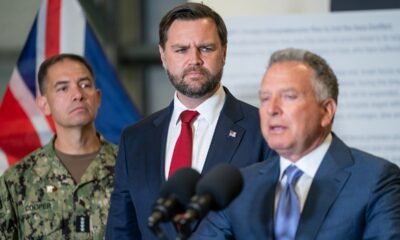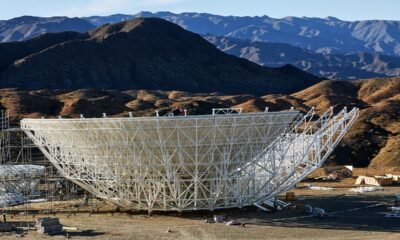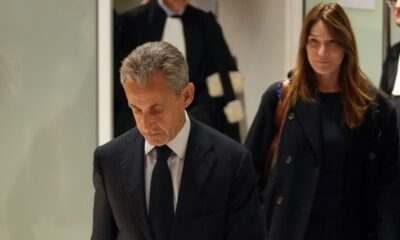INTERNACIONAL
Russia and China tick Doomsday Clock toward midnight as Hiroshima bombing hits 80 years
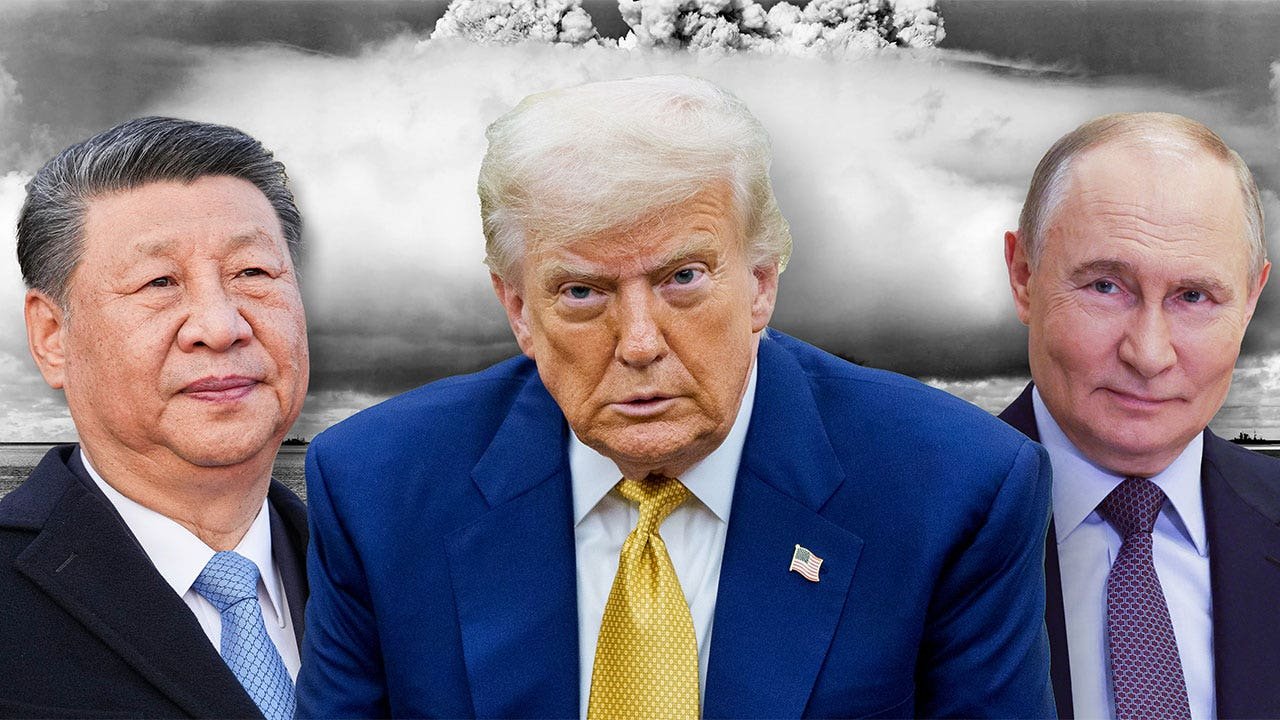
NEWYou can now listen to Fox News articles!
Wednesday marks the 80th anniversary of when the U.S. employed the first ever nuclear bomb over the Japanese city of Hiroshima, followed by the bombing of Nagasaki three days later on Aug. 9. But despite nearly a century of lessons learned, nuclear warfare still remains a significant threat.
«This is the first time that the United States is facing down two nuclear peer adversaries – Russia and China,» Rebeccah Heinrichs, nuclear expert and senior fellow at the Hudson Institute, told Fox News Digital.
Heinrichs explained that not only are Moscow and Beijing continuing to develop new nuclear capabilities and delivery systems, but they are increasingly collaborating with one another in direct opposition to the West, and more pointedly, the U.S.
TRUMP LIFTS VEIL ON US SUBMARINES IN WARNING SHOT TO KREMLIN IN ‘CLEVER’ REPOSITIONING MOVE
An aerial photograph of Hiroshima, Japan, shortly after the «Little Boy» atomic bomb was dropped in 1945. (Universal History Archive/UIG via Getty images)
«It’s a much more complex nuclear threat environment than what the United States even had to contend with during the Cold War, where we just had one nuclear peer adversary in the Soviet Union,» she said. «In that regard, it’s a serious problem, especially when both China and Russia are investing in nuclear capabilities and at the same time have revanchist goals.»
Despite the known immense devastation that would accompany an atomic war between two nuclear nations, concern has been growing that the threat of nuclear war is on the rise.
The bombings of Hiroshima and Nagasaki – which collectively killed some 200,000 people, not including the dozens of thousands who later died from radiation poisoning and cancer – have been attributed with bringing an end to World War II.
But the bombs did more than end the deadliest war in human history – they forever changed military doctrine, sparked a nuclear arms race and cemented the concept of deterrence through the theory of mutually assured destruction.
Earlier this year the Bulletin of Atomic Scientists moved forward the «Doomsday Clock» by one second – pushing it closer to «midnight,» or atomic meltdown, than ever before.
In January, the board of scientists and security officials in charge of the 78-year-old clock, which is used to measure the threat level of nuclear warfare, said that moving the clock to 89 seconds to midnight «signals that the world is on a course of unprecedented risk, and that continuing on the current path is a form of madness.»
TRUMP CONFIRMS 2 NUCLEAR SUBMARINES ARE ‘IN THE REGION’ TO COUNTER RUSSIA
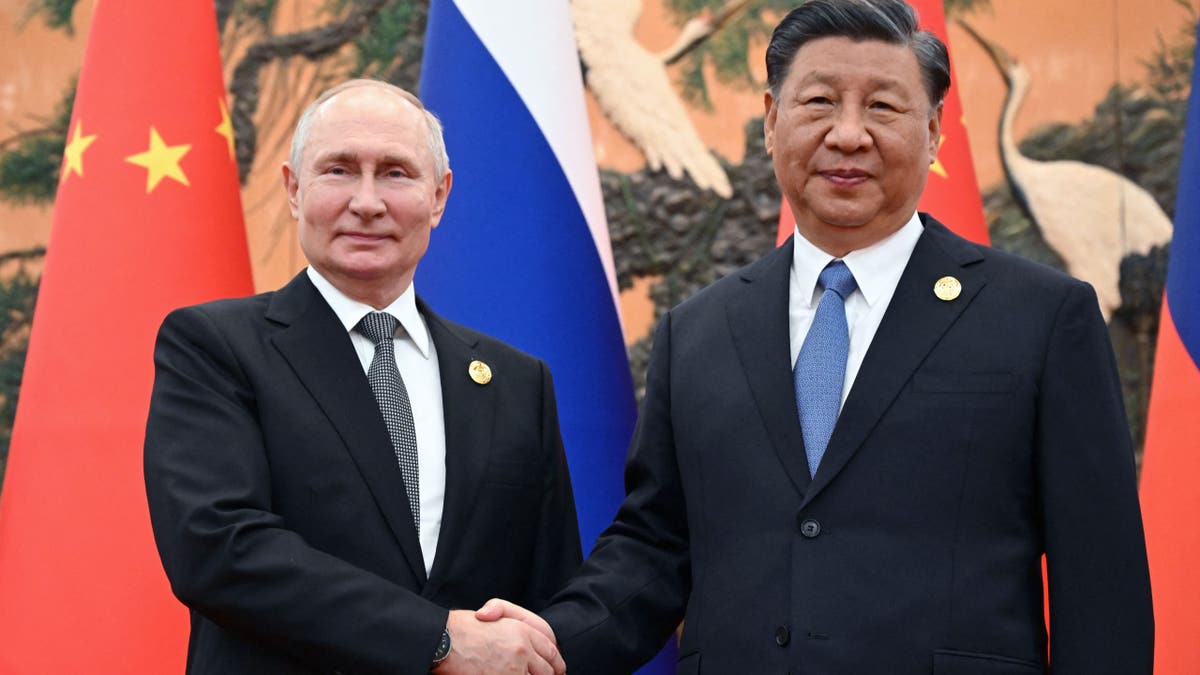
Russia’s President Vladimir Putin and Chinese President Xi Jinping shake hands during a meeting in Beijing on Oct. 18, 2023. (Sergei Guneyev/Pool/AFP via Getty Images)
Despite the escalated nuclear threats coming out of North Korea, and international concern over the Iranian nuclear program, the threat level largely came down to the three biggest players in the nuclear arena: Russia, the U.S. and China.
The increased threat level was attributed to Russia’s refusal to comply with international nuclear treaties amid its continuously escalating war in Ukraine and its hostile opposition to NATO nations, as well as China’s insistence on expanding its nuclear arsenal.
But the Bulletin, which was founded by scientists on the Manhattan Project in 1945 to inform the public of the dangers of atomic warfare, also said the U.S. has a role in the increased nuclear threat level.
«The U.S. has abdicated its role as a voice of caution. It seems inclined to expand its nuclear arsenal and adopt a posture that reinforces the belief that ‘limited’ use of nuclear weapons can be managed,» the Bulletin said. «Such misplaced confidence could have us stumble into a nuclear war.»
But Heinrichs countered the «alarmist» message and argued that deterrence remains a very real protectant against nuclear warfare, even as Russia increasingly threatens Western nations with atomic use.
«I do think that it’s a serious threat. I don’t think it’s inevitable that we’re sort of staring down nuclear Armageddon,» she said.
CHINA’S GROWING NUCLEAR ARSENAL AIMS TO BREAK US ALLIANCES AND DOMINATE ASIA, REPORT WARNS
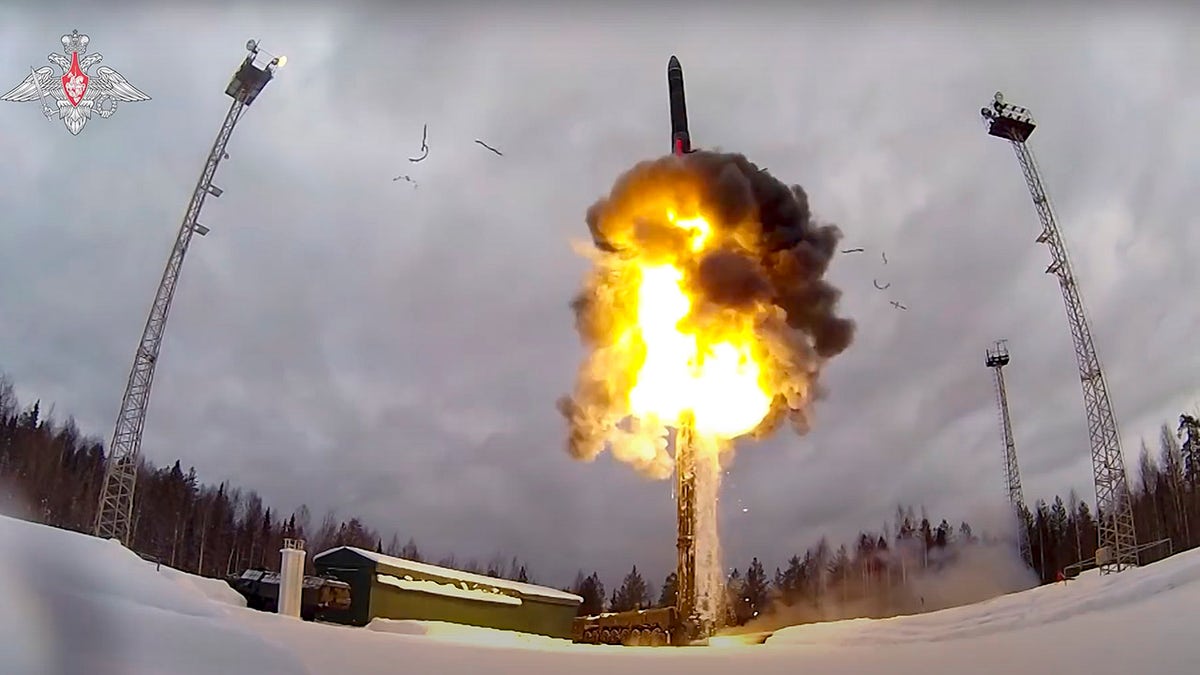
A Yars intercontinental ballistic missile is launched from an air field during military drills in Russia on Feb. 19, 2022. (Russian Defense Ministry Press Service via AP, File)
Heinrichs argued the chief threat is not the number of nuclear warheads a nation possesses, but in how they threaten to employ their capabilities.
«I think that whenever there is a threat of nuclear use, it’s because adversaries, authoritarian countries, in particular Russia, is threatening to use nuclear weapons to invade another country. And that’s where the greatest risk of deterrence failure is,» she said. «It’s not because of the sheer number of nuclear weapons.»
Heinrichs said Russia is lowering the nuclear threshold by routinely threatening to employ nuclear weapons in a move to coerce Western nations to capitulate to their demands, as in the case of capturing territory in Ukraine and attempting to deny it NATO access.
Instead, she argued that the U.S. and its allies need to improve their deterrence by not only staying on top of their capabilities but expanding their nuclear reach in regions like the Indo-Pacific.
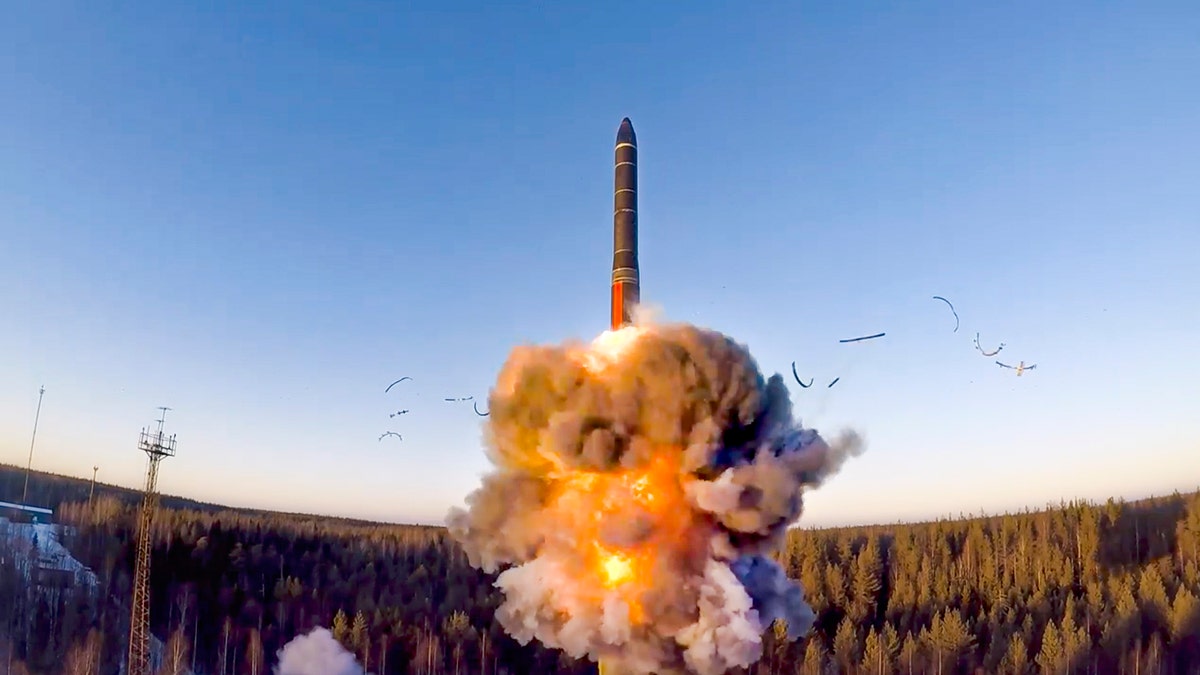
A rocket launches from missile system from the Plesetsk facility in northwestern Russia on Dec. 9, 2020. (Russian Defense Ministry Press Service via AP, File)
CLICK HERE TO GET THE FOX NEWS APP
«The answer is not to be so afraid of it or alarmed that you capitulate, because you’re only going to beget more nuclear coercion if you do that,» she said. «The answer is to prudently, carefully communicate to the Russians they are not going to succeed through nuclear coercion, that the United States also has credible response options.
«We also have nuclear weapons, and we have credible and proportional responses, and so they shouldn’t go down that path,» Heinrichs said. «That’s how we maintain the nuclear peace. That’s how we deter conflict. And that’s how we ensure that a nuclear weapon is not used.»
nuclear proliferation,russia,china,world war two,defense,world
INTERNACIONAL
Former GOP senator emerges from private sector with new mission: ‘Somebody has to step up’
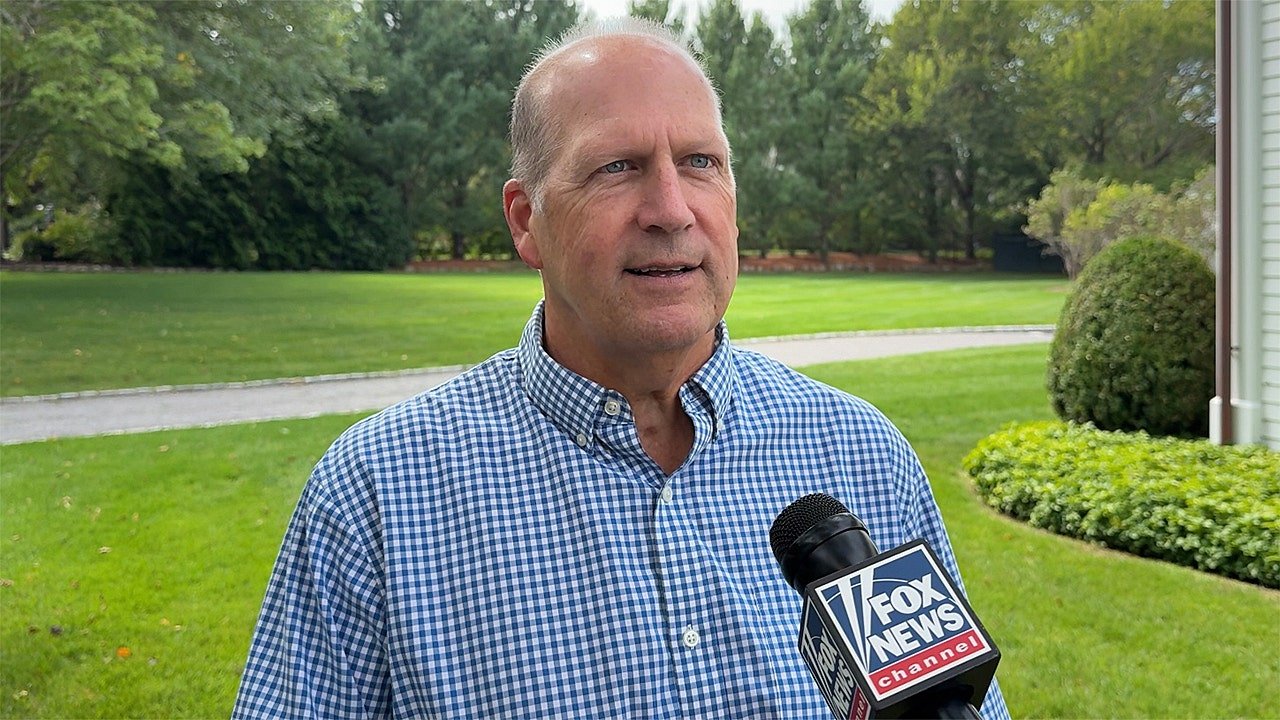
NEWYou can now listen to Fox News articles!
EXCLUSIVE: Former Republican Sen. John E. Sununu of New Hampshire wants his old job back.
And on Wednesday, Sununu took a big first step towards returning to Capitol Hill as he announced his candidacy in the 2026 race to succeed retiring Democratic Sen. Jeanne Shaheen in New England’s only swing state.
Sununu, in a campaign launch video shared first nationally with Fox News Digital, said that nowadays «Congress just seems loud, dysfunctional, even angry,» and that he wants to «return to the Senate to help calm the waters.»
Sununu is a former three-term representative who defeated then-Gov. Shaheen in New Hampshire’s 2002 Senate election. But the senator lost to Shaheen in their 2008 rematch.
HEAD HERE FOR THE LATEST FOX NEWS REPORTING ON THE 2025 ELECTIONS
Former Republican Sen. John E. Sununu of New Hampshire is interviewed by Fox News Digital, on Sept.15, 2025 in Rye, N.H. (Paul Steinhauser/Fox News Digital)
Shaheen announced earlier this year that she wouldn’t seek re-election in next year’s midterms and Republicans are working to flip the seat as they aim to not only defend but expand their Senate majority.
Now, after nearly two decades in the private sector, Sununu is ready to return to the Senate campaign trail in New England’s only swing state.
«Maybe you’re surprised that I’m running for the Senate again,» Sununu says to the camera in his video. «I’m a bit surprised myself. Why would anyone subject themselves to everything going on there right now. Well, somebody has to step up and lower the temperature. Somebody has to get things done.»
THUNE SPEAKS WITH SUNUNU ABOUT SENATE BID TO FLIP BLUE SEAT RED
Sununu is a brand name in New Hampshire politics. The former senator’s father, John H. Sununu, is a former governor who later served as chief of staff in then-President George H.W. Bush’s White House. And one of his younger brothers is former Gov. Chris Sununu, who won election and re-election to four two-year terms steering the Granite State.
But Sununu won’t have a glide path to the GOP nomination.
Former ambassador and former Sen. Scott Brown, who was elected and served three years in the Senate in neighboring Massachusetts, and who, as the 2014 GOP Senate nominee in New Hampshire, narrowly lost to Shaheen during her first re-election, jumped into the race in late June.
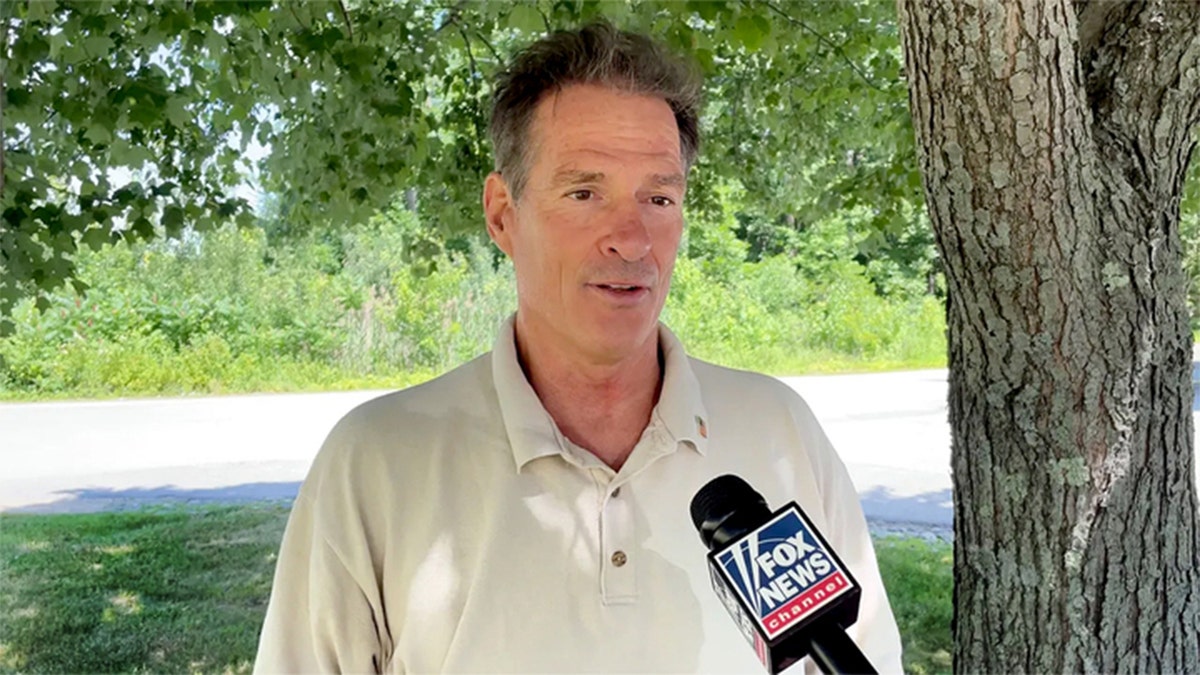
Former Sen. Scott Brown, who launched a Republican Senate campaign in New Hampshire in June, is interviewed by Fox News Digital, on July 4, 2025, in Exeter, N.H. (Paul Steinhauser/Fox News )
«Our campaign will have the necessary resources for the long haul, and allow me to campaign the only way I know how: relentless hard work and a focus on retail politics that Granite State voters expect,» Brown said after Fox News first reported that he hauled in roughly $1.2 million in fundraising the past three months.
Brown has repeatedly taken aim at Sununu the past month over the former senator’s lack of past support for President Donald Trump, who holds immense clout over the GOP.
TOP POLITICAL HANDICAPPER REVEALS DEMOCRATS CHANCES OF WINNING BACK THE SENATE MAJORITY
Sununu served as national co-chair on the 2016 Republican presidential campaign of then-Ohio Gov. John Kasich, who declined to support Trump as the party’s nominee.
And Sununu, along with then-Gov. Chris Sununu, endorsed former ambassador and former South Carolina Gov. Nikki Haley in the 2024 New Hampshire Republican presidential primary, as she battled Trump for the nomination.
And on the eve of the first-in-the-nation presidential primary, the former senator wrote an opinion piece titled «Donald Trump is a loser,» that ran in the New Hampshire Union Leader, the state’s largest daily newspaper.
Brown endorsed Trump ahead of his 2016 New Hampshire primary victory, which launched him toward the GOP presidential nomination and ultimately the White House. Brown later served as U.S. ambassador to New Zealand during Trump’s first term.

Sen. Jeanne Shaheen, D-N.H., seen speaking at a policy event in Concord, New Hampshire on Oct. 22, 2024, is not seeking re-election next year. (Steven Senne/AP Photo)
«Anyone who thinks that a never Trump, corporate lobbyist who hasn’t won an election in a quarter century will resonate with today’s GOP primary voters is living in a different universe. While John was supporting John Kasich in 2016, I was campaigning with Donald Trump,» Brown charged in a statement to Fox News.
And pointing to Sununu’s past decade and a half in the private sector, Brown argued that «while John was fighting for special interests, I was serving in the first Trump administration. While John was wooing the DC establishment this summer, I have been working with grassroots activists across the Granite State. Senate seats are earned, not handed down.»
TRUMP NOT ON BALLOT BUT FRONT-AND-CENTER IN 2025 ELECTIONS
Trump, whose endorsement in Republican primaries is extremely influential, has remained neutral to date.
But the president may be willing to overlook Sununu’s past jabs.
Earlier this year, when Chris Sununu flirted with a Senate bid after leaving office, Trump urged him to run.
The younger Sununu, who was Haley’s top supporter and surrogate in New Hampshire, repeatedly criticized Trump during the 2024 Republican presidential primaries.

Former Ambassador and former South Carolina Gov. Nikki Haley, center, is joined by then-New Hampshire Gov. Chris Sununu, right, as they visit a polling location to greet voters casting ballots in the state’s first-in-the-nation presidential primary, on Jan. 23, 2024, in Hampton, New Hampshire. (Joe Raedle/Getty Images)
Trump told reporters in April that he had met with the former governor in the Oval Office and that he’d «support him fully.»
«He’s been very nice to me over the last year or so,» Trump added. «I hope he runs. I think he’ll win that seat.»
FIRST ON FOX: SCOTT BROWN SHOWCASES HEALTHY WARCHEST
And a national Republican strategist familiar with the Senate race in New Hampshire told Fox News Digital last month, «President Trump appreciates winners and understands that John E. Sununu puts this race on the map for Republicans.»
As Fox News reported, Sununu met last month with Senate Majority Leader John Thune and former Sen. Cory Gardner, who served as chair of the Senate Leadership Fund, which is the top super PAC supporting Senate Republicans. National Republicans view Sununu as the strongest candidate to win back the seat in New Hampshire.
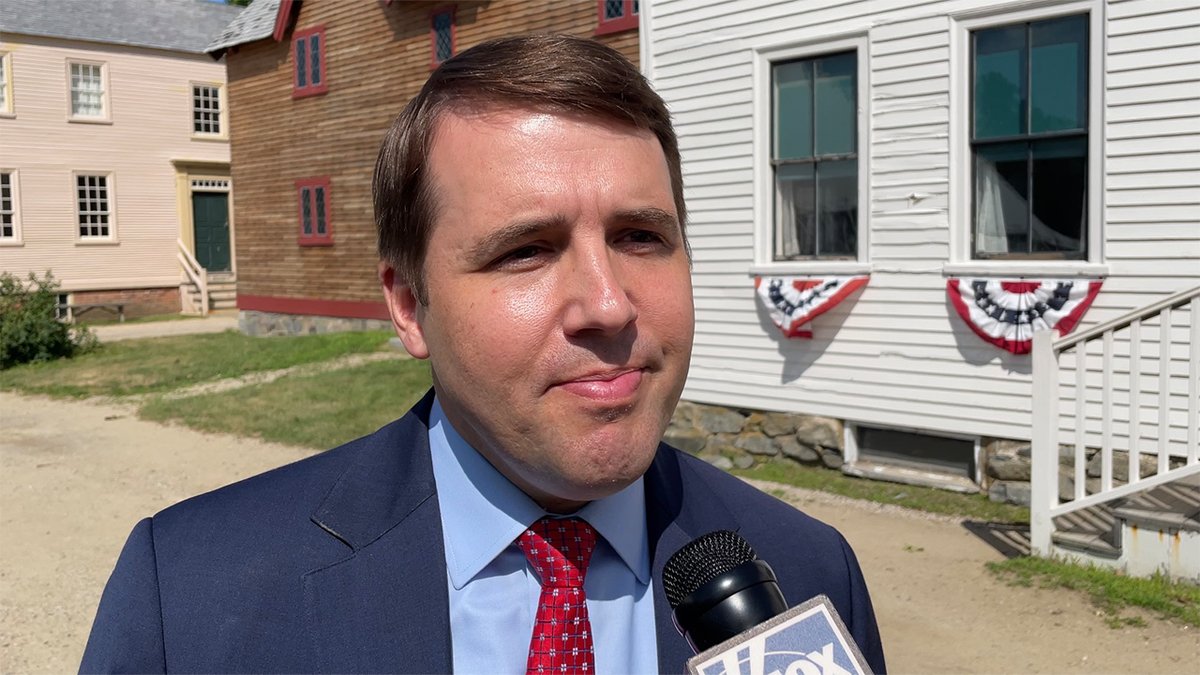
New Hampshire Democratic Senate candidate Rep. Chris Pappas is interviewed by Fox News Digital on July 4, 2025, in Portsmouth, N.H. (Paul Steinhauser/Fox News Digital)
Four-term Democratic Rep. Chris Pappas, who launched his Senate campaign in early April, is the clear frontrunner for his party’s nomination.
CLICK HERE TO GET THE FOX NEWS APP
While New Hampshire has for over a century held the first-in-the-nation presidential primary, its state primary, which will be held next September, is one of the last-in-the-nation.
While Republicans have had success in state elections — they control the governor’s office and both chambers of the state legislature — the GOP hasn’t won a Senate election in New Hampshire since 2010.
elections,midterm elections,republicans elections,senate elections,new hampshire,donald trump,campaigning,politics
INTERNACIONAL
Cómo el estrés acelera el envejecimiento biológico: claves y consejos para revertirlo, según la ciencia

El estrés puede acelerar el proceso de envejecimiento biológico en personas de todas las edades. Esto ocurre cuando el organismo enfrenta situaciones que exceden sus recursos, lo que produce una sobrecarga que afecta tanto la salud física como la mental.
Distintos estudios científicos señalan que las marcas del estrés intenso en el cuerpo son visibles, pero reversibles si la causa desaparece. La relación entre el estrés y el envejecimiento despierta un interés especial en la actualidad, donde la expectativa de vida supera los 60 años en gran parte del mundo.
En ese sentido, expertos consultados por Psicología y Mente aseguraron que es esencial comprender la diferencia entre la edad cronológica y la edad biológica. La primera define el tiempo transcurrido desde el nacimiento de una persona.

En cambio, la edad biológica se refiere al estado real del organismo en comparación con ese tiempo. Este concepto incorpora la genética y los hábitos de vida. Un factor relevante es el estrés, que podría provocar que la edad biológica aumente y se distancie de la cronológica, acelerando así el envejecimiento.
De acuerdo con la información presentada por los especialistas, el estrés es una reacción natural frente a demandas que superan la capacidad de respuesta del individuo. El cuerpo y la mente activan este proceso para afrontar situaciones adversas.
Esta activación permite superar obstáculos, mejora la eficiencia y favorece la adaptación en ciertas circunstancias. Sin embargo, si la recuperación no se produce y el estrés persiste, el organismo sufre un desgaste significativo que afecta las funciones físicas y mentales.

Los síntomas del estrés afectan varios ámbitos de la salud. Entre los más habituales se encuentran dolores de cabeza, trastornos digestivos, rigidez en la mandíbula, fatiga y cansancio. Además, investigaciones recientes demuestran que el impacto no se limita a molestias puntuales, sino que también propicia un envejecimiento acelerado a nivel biológico.
Ciertos momentos de la vida, como una cirugía, una internación en la unidad de cuidados intensivos por una enfermedad como el COVID-19, o el embarazo, pueden generar un aumento medible en la edad biológica. Un trabajo publicado en la revista Cell Metabolism documentó que el incremento en la edad biológica, producido en estos escenarios, puede revertirse días o meses después cuando desaparece la causa del estrés.
En tanto, un estudio previo, también publicado en Cell Metabolism, demostró que incluso una sola noche de privación de sueño genera aumentos medibles en la edad biológica a través de marcadores epigenéticos e inmunológicos. Sin embargo, los investigadores comprobaron que estos efectos pueden revertirse completamente cuando se restablecen patrones normales de descanso.

En ese tono, la investigación dirigida por Jesse R. Poganik y su equipo, perteneciente al Departamento de Medicina del Brigham and Women’s Hospital, Facultad de Medicina de Harvard, examinó muestras de sangre en pacientes mayores que se sometieron a una intervención quirúrgica.
Según los datos obtenidos, la edad biológica mostró una notable elevación inmediatamente antes del procedimiento. Sin embargo, los valores regresaron a lo habitual entre cuatro y siete días después de la operación. El estudio también incluyó a personas hospitalizadas por COVID-19 y a mujeres gestantes. En ambos grupos, una vez finalizada la situación estresante, la edad biológica volvió a registros similares a los anteriores.
El patrón se observa con claridad: mientras el factor estresante está presente, la edad biológica aumenta. Cuando se elimina ese factor, el cuerpo puede recuperar su estado anterior. Este hallazgo genera optimismo, ya que indica que los efectos negativos del estrés sobre el envejecimiento no resultan definitivos en la mayoría de los casos.

De acuerdo con información recopilada en Psicología y Mente, la resiliencia psicológica cumple un rol fundamental en la protección frente a los daños del estrés. Las personas con mayor capacidad de adaptación a las dificultades experimentan menos aceleración en el envejecimiento biológico. Investigadores observaron que quienes regulan mejor sus emociones y mantienen autocontrol logran mayor resistencia a los efectos del estrés en el organismo.
La adopción de hábitos saludables también contribuye a reducir el impacto negativo del estrés sobre el proceso de envejecimiento. Según los especialistas citados por Psicología y Mente, una alimentación equilibrada, la actividad física regular, la abstinencia de tabaco y alcohol, y el cuidado emocional favorecen la prevención de enfermedades y fortalecen la capacidad de recuperación. Estas pautas ayudan a mantener durante más tiempo la autonomía y la calidad de vida.
La ciencia considera el envejecimiento como una acumulación de daños celulares y moleculares, un proceso que se acelera cuando el cuerpo se ve sometido de manera sostenida a situaciones que generan estrés. Este desgaste puede reducir la funcionalidad física y mental, aumentar el riesgo de enfermedades e, incluso, adelantar la aparición de dependencia.

Los resultados de las investigaciones recientes revelan la importancia de prestar atención a los signos de estrés y de buscar recuperarse en forma activa. Cuando las personas logran calmar los factores que les provocan sobrecarga, los indicadores biológicos mejoran y la “edad” del organismo desciende hasta alcanzar registros normales.
El conocimiento sobre la relación entre estrés y envejecimiento permite a individuos y comunidades actuar de manera informada. La salud integral requiere atención tanto en el plano físico como en el mental. La detección y la gestión efectiva del estrés, sumadas a la resiliencia y a estilos de vida saludables, constituyen las mejores estrategias para cuidar el cuerpo y mantener el bienestar a lo largo de los años.
El control del estrés, la adopción de hábitos sanos y el fortalecimiento emocional se imponen así como claves en la búsqueda de una vida larga y plena. La evidencia muestra que evitar el impacto negativo del estrés está al alcance de la mayoría si se asumen conductas de cuidado y prevención.
adult,anxiety,burnout,business,business operations,business pressure,business tasks,businesswoman,camera,challenges,company,computer,corporate,deadline,deadlines,disappointment,emotional strain,employee,enterprise,entrepreneur,executive,exhaustion,fatigue,financial,frustration,goals,growth,headache,laptop,low energy,manager,managing,mental,mental exhaustion,migraine,multinational company,objectives,office,office burnout,overload,overwhelmed,pressure,professional,professional struggle,project,projects,stress,successful,technology,tough day,woman,worker
INTERNACIONAL
Speaker Johnson hit with Democrat-led lawsuit over delayed swearing-in amid House shutdown chaos
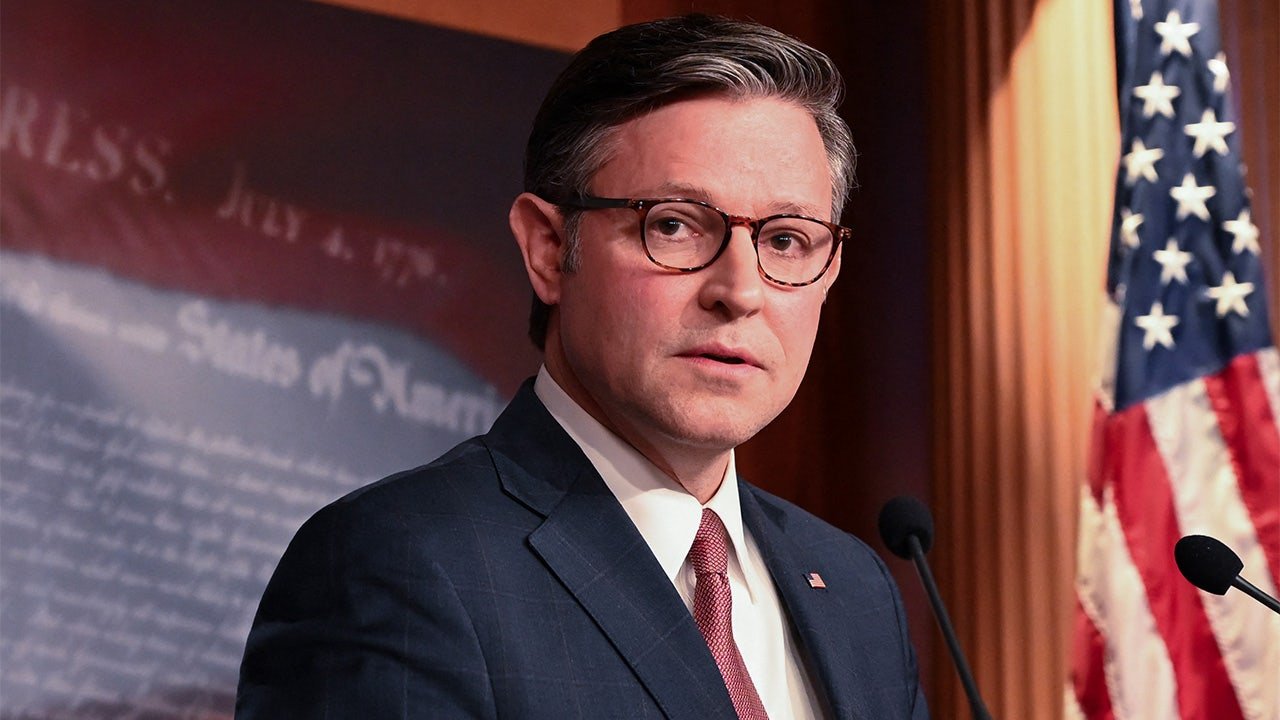
NEWYou can now listen to Fox News articles!
The state of Arizona is suing Speaker Mike Johnson, R-La., over the delayed swearing-in of Rep.-elect Adelita Grijalva, D-Ariz.
«Speaker Mike Johnson is actively stripping the people of Arizona of one of their seats in Congress and disenfranchising the voters of Arizona’s seventh Congressional district in the process,» Arizona Attorney General Kris Mayes, a Democrat, said in a statement.
«By blocking Adelita Grijalva from taking her rightful oath of office, he is subjecting Arizona’s seventh Congressional district to taxation without representation. I will not allow Arizonans to be silenced or treated as second-class citizens in their own democracy.»
Johnson dismissed the lawsuit as a bid to get «national publicity» in comments to reporters earlier this week and on Tuesday evening.
BATTLEGROUND REPUBLICANS HOLD THE LINE AS JOHNSON PRESSURES DEMS ON SHUTDOWN
Speaker of the House Mike Johnson speaks during a news conference at the U.S. Capitol on the tenth day of the federal government shutdown on Oct. 10, 2025, in Washington, D.C. (Alex Wroblewski/AFP via Getty Images)
«I think it’s patently absurd. We run the House. She has no jurisdiction. We’re following the precedent,» Johnson said in response to the state attorney general. «She’s looking for national publicity, apparently she’s gotten some of it, but good luck with that.»
Grijalva won a special election on Sept. 23 to replace her father, late Rep. Raul Grijalva, D-Ariz., after he passed away from cancer at age 77.
Johnson has repeatedly said that Grijalva will be sworn into office when the House returns to its regular sessions. But it’s not clear when exactly that will be — the House GOP leader has threatened to keep his lawmakers out of Washington, D.C., until the ongoing government shutdown is over.
It’s a bid to pressure Senate Democrats, led by Minority Leader Chuck Schumer, D-N.Y., to agree to the GOP’s plan to fund the federal government through Nov. 21.
But Schumer and his allies have resisted thus far, sinking the Republican-led bill 11 times and keeping the shutdown going for 21 days.
House Democrats have accused Johnson of playing politics and depriving Arizona’s 7th Congressional District of representation in the process.
«Republicans on vacation for four weeks — and one of the consequences of that is that Republicans have refused, now for four consecutive weeks, to swear in Representative-elect Adelita Grijalva, depriving hundreds of thousands of people in the state of Arizona of the representation that they deserve, particularly during this challenging moment in the country,» House Minority Leader Hakeem Jeffries, D-N.Y., said during a press conference on Tuesday.

Rep.-elect Adelita Grijalva is interviewed in Tucson, Arizona, on July 15, 2025 (Rebecca Noble/Getty Images)
Johnson, in response to Democrats’ criticism, has repeatedly pointed out that the House was not in session when Grijalva won her election.
He’s also argued that he was following precedent set by former Speaker Nancy Pelosi, D-Calif., who waited 25 days to swear in Rep. Julia Letlow, R-La., in 2021.
Letlow had won a special election to replace her husband, Rep.-elect Luke Letlow, R-La., who died during the COVID-19 pandemic before he could be sworn into office in January 2021.
«We are not in legislative session. The chronology is important. Rep. Grijalva won her race, I think it was the last week of September, after we had already gone out of session. So I will administer the oath to her, I hope, on the first day we come back,» Johnson said.
58 HOUSE DEMS VOTE AGAINST RESOLUTION HONORING ‘LIFE AND LEGACY’ OF CHARLIE KIRK
«I’m willing and anxious to do that. In the meantime, instead of doing TikTok videos, she should be serving her constituents.»
Grijalva has argued she cannot perform her legislative or constituent duties without being sworn in first, which Johnson and Republicans have disputed.
But her swearing-in is also key to the ongoing battle over Jeffrey Epstein documents going on in the House.
Once made a member of Congress, Grijalva is expected to be the deciding signature on a measure aimed at forcing a House-wide vote on releasing Epstein documents in the Department of Justice’s (DOJ) possession.
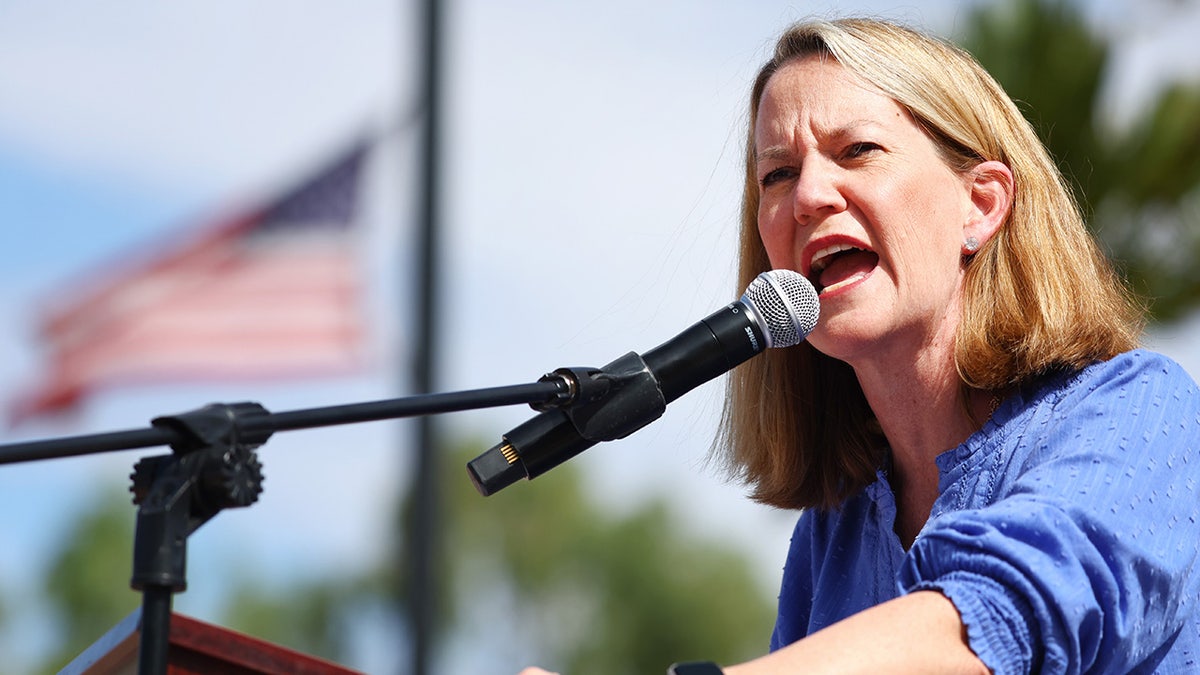
Arizona Attorney General Kris Mayes, then a Democratic candidate for her role, speaks at a Women’s March rally outside the State Capitol on Oct. 8, 2022 in Phoenix, Arizona. (Mario Tama/Getty Images)
CLICK HERE TO GET THE FOX NEWS APP
The measure, called a discharge petition, is designed to end-run House leaders on specific legislation — provided it has a majority of lawmakers’ signatures.
Johnson and House GOP leaders have called the measure superfluous and political, pointing to the chamber’s own ongoing investigation and procedures aimed at widening transparency into Epstein’s case.
However, the speaker has signaled he would not block the measure if it came to the House floor when Grijalva was sworn in.
Fox News Digital reached out to Johnson for a response but did not immediately hear back.
house of representatives politics,democrats,politics,mike johnson,arizona

 CHIMENTOS2 días ago
CHIMENTOS2 días agoLa cruda confesión del Turco Naim a 1 año de la separación de Emilia Attias: «Me di cuenta que hay que aprender a estar solo»

 POLITICA3 días ago
POLITICA3 días agoExigen que Cristina Kirchner y los candidatos de Fuerza Patria aclaren si fueron financiados por el narco venezolano

 CHIMENTOS2 días ago
CHIMENTOS2 días agoPampita recibió un video inesperado de su hija Blanca en el Día de la Madre y no pudo contener la emoción



